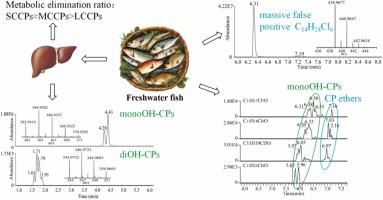Oxidative metabolism of chlorinated paraffins by freshwater fish liver microsomes: major metabolites detected in marketable freshwater fish
IF 12.2
1区 环境科学与生态学
Q1 ENGINEERING, ENVIRONMENTAL
引用次数: 0
Abstract
The emerging environmental pollutant class of chlorinated paraffins (CPs) has garnered increasing concern in recent years. The oxidative metabolism of CPs by fish is an important pathway for the degradation of CPs present in aquatic ecosystems. However, the factors affecting the oxidative metabolism of CPs by fish are poorly understood, with only a few studies having examined CP metabolites in fish; research that focuses on fish from the natural environment is even more scarce. In the present study, single and mixed CP standards were incubated in vitro with fish liver microsomes to study the formation of CP metabolites. In addition, the presence of CPs and associated metabolites were analyzed in marketable freshwater fish. The in vitro fish liver microsome experiments showed the metabolic elimination ratio of short-chain CPs ≈ medium-chain CPs > long-chain CPs. Both mono- and di-hydroxylated oxidative metabolites of CPs were identified. Importantly, although both monohydroxylated CPs (monoOH-CPs) and CP ethers were detected in the tested marketable fish, only monoOH-CPs were confirmed as oxidative metabolites of CPs; moreover, a large amount of false positive C14H24Cl6 was detected. This study provides valuable insights into the biotransformation of CPs in fish. The results highlight the importance of chromatographic separation when analyzing CPs and associated metabolites in fish. Further, assessments of the ecological/health risks of CPs should pay special attention to monoOH-CPs since these species may have higher toxicities than the parent compounds.

求助全文
约1分钟内获得全文
求助全文
来源期刊

Journal of Hazardous Materials
工程技术-工程:环境
CiteScore
25.40
自引率
5.90%
发文量
3059
审稿时长
58 days
期刊介绍:
The Journal of Hazardous Materials serves as a global platform for promoting cutting-edge research in the field of Environmental Science and Engineering. Our publication features a wide range of articles, including full-length research papers, review articles, and perspectives, with the aim of enhancing our understanding of the dangers and risks associated with various materials concerning public health and the environment. It is important to note that the term "environmental contaminants" refers specifically to substances that pose hazardous effects through contamination, while excluding those that do not have such impacts on the environment or human health. Moreover, we emphasize the distinction between wastes and hazardous materials in order to provide further clarity on the scope of the journal. We have a keen interest in exploring specific compounds and microbial agents that have adverse effects on the environment.
 求助内容:
求助内容: 应助结果提醒方式:
应助结果提醒方式:


